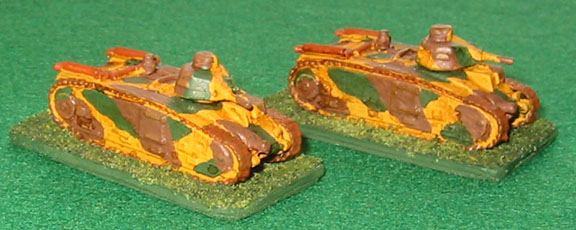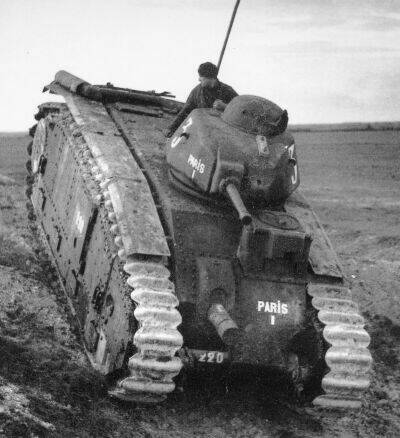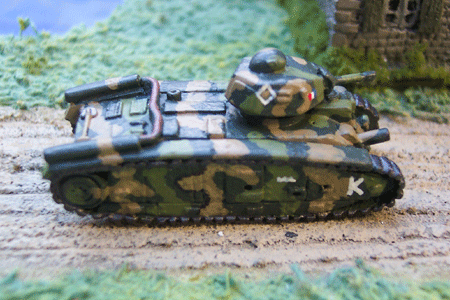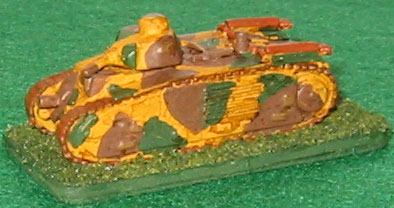|
CHAR B1 bisDescriptionThis B1 bis heavy tank represented the principle striking force of the Reserve Armoured Divisions (DCR) and was one of the most advanced tanks of its time.
DevelopmentThe initial requirement for the Char B1, known as le char de bataille (the battle tank) was drawn up in 1921 and called for a 13-ton vehicle with a maximum armour plate thickness of 25mm to be armed with a hull mounted 75mm gun for infantry support and two machine-guns situated in a rotating turret. Four companies built prototypes. The Schneider-Renault prototype was chosen as the basis for the new tank along with its steering mechanism, engine and gearbox. The suspension and running gear were taken from the FAMH prototype and the tracks from the FCM prototype. A contract for three prototype Char B1s was placed with Renault on 17th January 1926 and delivery started in January 1929. These tanks weighed 25 tonnes, had a crew of four and a maximum of 25mm armour. They were armed with one 75mm hull gun, two hull machine guns, and two turret-mounted machine guns. Trials continued until 1935, by which time the maximum armour had increased to 40mm which increased the weight to 28 tonnes. In March of 1935 the Germans re-occupied the Rhineland 40 Chars B1s were ordered while at the same time design work started on an up-armoured version designated the Char B1 bis The Char B1s were based on the prototype tanks but with a cast APX 1 turret armed with a 47mm SA 34 short-barrelled cannon and coaxial machine gun. Only 35 were completed before production switched in 1938 to the Char B1 bis. Only a few Char B1 tanks saw service in hastily put together units after the German invasion. The Char B1 bis with its extra armour weighed 32 tonnes and therefore needed a more powerful 300 hp Renault engine to haul the weight. The APX 1 turret was exchanged for the similar but thicker APX 4 turret that mounted the improved 47mm SA 35 long-barrelled cannon and coaxial machine gun. Even though production of the B1 bis was ordered in 1935 it was known to have certain disadvantages; the sidewalls and tracks had proven vulnerable to armour-piercing shells and practical experience had revealed the disadvantage of aiming the 75mm gun solely by aligning the tank. The new design called B1 ter would improve this give this gun a mounting with a limited traverse of five degrees each way and increase armour from 60mm to 75mm. Only three were completed by June 1940 and these were sunk while aboard a cargo ship.
OperationThe driver sat at the left front of the vehicle. He was the only crew member apart from the commander who had any means to see what was going on outside. In addition to driving he also used the Naeder steering system to line up the 75mm SA 35 hull gun as it couldn't traverse left or right. A 7.5 mm machine-gun was on the right of the hull, and could be fired via a cable connection by the driver or the commander. The loader and wireless operator were both situated at the base of the tank commander’s feet. The loader served the two hull guns; the 75mm and the machine-gun. The 75mm HE shells needed to be fused before loading which increased the work-load for the loader and reduced the guns rate-of-fire. The loader also provided ammunition to the tank commander when the 47mm ready-rounds were used up. The wireless operator could also assist the commander in loading the turret gun although there was not enough space for him in the turret. The tank commander was the sole occupant of the cast APX 4 turret which was armed with the 47mm SA 35 high velocity armour piercing gun along with a coaxial machine-gun and equipped with electric power traverse. The turret had a cupola where most other tanks would have a turret hatch. The commander could not raise his head out of the turret and thus had a more restricted view than was possible for German tank commanders who often when into battle so. The commander was very overworked in a one-man turret. Apart from commanding the tank and directing the driver, fired and loaded the turret cannon. So in action he would have his head in the cupola directing the driver, he would then have to spot the target and jump down into the turret when he would rotate the turret onto the target, peer through the gun-sight and set the range, fire the gun, and then reach down and grab a new round and load. The commander’s life in the B1 was easier than in the two-man light tanks because he at least had a radio operator to help him communicate and perhaps even load and turret rotation was electrically instead of manually. The crew normally communicated by shouting at each other over the noise of the engine. There were a number of lights that allowed the commander to communicate simple orders to the driver such as turn right/left, increase/decrease speed or cease fire. Although not generally available, an intercom system with throat microphones and headphones had been tested in 1940. There was a radiator on the right hand side of the hull. Myth has it that this was a weakness and became a favourite aiming point for German gunners. However the armour over the radiator was no weaker than the rest of the side and the examination of several hundred wrecks does not show a particular concentration of impacts on this zone.
RadioThe tanks were origanlly equipped with an ER 53 mle 1932 radio which was morse key-only and had a range of 15 km. Early 1940 these were replaced by the ER 51 mle 1938 which had both voice and morse key as well as a slightly improved range of 15-20 km. Command tanks had a second radio operator and probably also an ER30 which had a maximum range of 20km when moving and 40km when stationary. The radios were very unreliable and had problems with short battery-life. StonneWhen used correctly, and not plagued by unreliability, the B1 bis was a deadly tank as proven at the town of Stonne on 16th May 1940. Even the radios worked that day! The day started at 3am with commandant Malaguti of the 41st tank battalion (BCC) 3rd Armoured Division (DCR) leading the attack in his B1 bis Vienne. The advance is in V formation with the 7 tanks of 1st company in echolon to the left and the 7 tanks of 3rd company in echelon to the right. The attack is supported by 10th & 11th companies of 3rd battalion 51st Infantry Regiment from the 3rd Motorised Infantry Division (DIM) and their direct support the 2nd company 45th BCC (Hotchkiss H39 tanks). At 5:15am the first German opposition was encontered; the Infantry Regiment Grossdeutschland supported by two tanks. The two tanks are quickly destroyed without loss and the 41st BCC continued its advance towards the enemy. Grossdeutschland kept up an intesive fire including anti-tank guns until the B1 bis reached 100m when most of the German feld, those that remained in their foxholes were mopped up by the following infantry. The B1 bis Eure commanded by capitaine Billotte, from the 1st company 41st BCC, then proceded to enter the town where it met head on a column of 13 German tanks from the 10th Panzer Division's 8th Panzer Regiment. At a range of only 30m, capitaine Billotte used the 47mm to destroy the first tank in the column while his driver sergent Durupt took out the last tank using the 75mm. Eure then advanced and destroyed the remaining 11 tanks. Leaving the smouldering wrecks of 2 Panzer IV and 11 Panzer III tanks in its wake, Eure then advanced to complete its days work by destroying two 37mm PAK 36 anti-tank guns. During the course of the day, Eure had been hit 140 times, but none of the shots had penetrated. During the same battle, the B1 bis Somme was attacked by two 37mm PAK 36 anti-tank guns but these again failed to penetrate even at a range of 100m. They did however manage to destroy the optics of the cupola. As Somme advanced it fell into an unseen gully on its side. Somme was set on fire by its crew to prevent it falling into German hands and then the crew returned to their own lines. Of the four B1 bis tanks lost in the battle that day, only one was destroyed by eneny action: Vertus. The Trépail had a mechanical breakdown, Somme was immobilized in a gully and Meursault was first immobilized in a gully and after being pulled out later had a mechanical breakdown. DeploymentChar B1 bis tanks equipped the four Reserve Armoured Divisions (DCR). The first three DCRs had 68 B1 bis tanks per division together with 90 Hotchkiss H 39 light tanks. There was a shortage of tanks when the 4th DCR was mobilised so it had some of its B1 bis heavy tanks replaced by D2 medium tanks and R 35 light tanks instead of H 39. 10th May 1940When the Germans's attacked the French army had the following 206 Char B1bis tanks on active service.
During the fighting the following tanks were added.
Tank NamesIndividual tank names were carried by most B1 and B1 bis tanks. Names on other types of tank were rare. The names were painted on some or all of the following: turret side, hull front and hull side. The names had often, but not always, a small French flag painted underneath them.
Technical Data
| ||||||||||||||||||||||||||||||||||||||||||||||||||||||||||||||||||||||||||||






